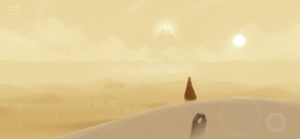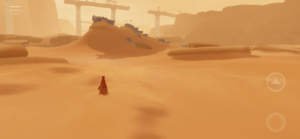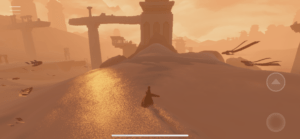For this next critical play, I played the quintessential walking simulator: Journey. Initially released in 2012, Journey still holds up to the many games of today. Created by Thatgamecompany and targeted at everyone, it was released on Playstation, but later ported onto mobile platforms where I played on iOS. (I’d also argue, it’s for a more casual audience as opposed to hardcore gamers). It takes the simplest mechanic of walking, but lifts it up through its amazing ability to tell a story. Specifically, Journey tells its story through exploration and immersion.
However, these aspects are not unique to Journey itself. Rather, the dual execution of exploration and immersion allows the story to flourish amongst simple game play mechanics. The most text you’ll encounter in the game is the title itself, and it is quite self explanatory within this. You play as a nameless red-cloaked figure, wandering a vast and empty desert.
[Introduction to Journey]

This naturally lends itself to the exploration aspect, as once you do discover something in the desert, it’s connected to the story. As you walk around, you slowly discover ruins, which feed you breadcrumbs of the story, one at a time. Besides walking, the only other action you can do is a music pulse(?). This pulse move is often used to interact with the different ruins that you discover. Alongside these ruins, you also encounter little critters that serve different purposes. During my short playthrough, I encountered a flurry of flying paper notes and manta-ray-like flying fabrics. When touching or coming into close proximity with both I was able to use a jumping move. In conjunction with the music pulse, I could call both close to me and interact with them in various ways. The flurry of flying notes would empower my next jump allowing me to jump higher and farther. The manta-ray-like fabrics on the other hand would wisp my character up. They also served as guides leading me from one place to the next. Here, the discovery of the story is baked into the discovery of the game mechanics as well. By unlocking certain creatures, I was able to unlock different moves, which in turn helped me solve some of the puzzles that then progressed the story.
[Flurry of Paper Notes]

The puzzles themselves were simple; using the pulse move near worn-out red fabric would solve a piece of whichever puzzle I was on. Typically, all the puzzles culminated in a final terrace where again the music pulse is used to activate a gem-like stone that would progress me onto the next (assumed) level.
[Solved Puzzle]

While exploration appears to be a necessary part of any walking simulator, what truly separates Journey is its level of immersion. The vastness of the desert evokes this sense of solitude that drives the player to discover and explore. The looming mountain in the distance also served as the ideal goal that directs the player. Additionally, the visual design naturally lends itself to the game. During the first level, the landscape was filled with brown, yellow, and orange hues. The sand took on a milder yellow-brown tone that made the character in its mahogany red cape stand out. The structures instead were of rustic-orange colors that kept to the same palette but also evoked the sense of ruins. The music pulse and interactions with the creatures all had white colored animations that also felt fitting in the empty desert. The music itself adds texture to the immersive feel. The soft strings and fluttering woodwinds are all evocative of the desert, and stimulates the solitude of the character. The pulse itself doesn’t play the same note when spammed, an added bonus. Additionally, the desert itself felt alive. There were gusts of winds that would fly sand particles across my screen, or the sand underneath would rumble and move.
[Rumbling Sand]

In level two, the landscape changed. The sand this time took on a whiter, lighter tone. The entire land felt more washed out, accentuating a redder look reflected in the sand, and clearer sky. The level also took the character closer to the looming mountain from the beginning, aiding in this sense of progression.
[Intro to level 2]

Here, I also discovered new modes of transportation that stretches the boundaries of what a walking simulator can be. Level two felt more hilly than the previous one, which allowed my character to glide and slide down hills. This quickened the pace of the game as the desert backdrop was huge and the character often felt slow when walking. Additionally, the flying manta-ray-like fabrics (when the game permitted) would help my character fly. This sense of progression not only adds depth to the story telling (why can I fly with some critters but not others?) but also moves the character along without making the player have to walk everywhere. I believe this can be a big pain point when it comes to designing large-scoped walking simulators. How can we explore the entire world if all we can do is walk?
[Flying]

[Gliding]

The last level I encountered up to writing this critical play also had a very interesting level design. Again the landscape changed, and this time it evoked a sense of being underwater. How it managed to do this, absolutely blew me away. I’m still in the desert, but everything has completely changed. This time, the character is situated under a larger set of ruins (again closer to the mountain). Everything is dark, with minimal light filtering through. The music itself also disappears and goes eerily quiet. One of the first puzzles also has floating, reaching banners that recalls the image of seaweed growing at the ocean floor.
[Intro to level 3]

[Seaweed Image]

The camera work itself also adds an extra dimension to the immersion. By allowing a free moving camera, it doesn’t feel like the player is confined to a set path. It really feels as if you could explore in any direction. There’s also a portion when the camera direction does lock and does change, but it does so for the sake of visuals.
[Camera locked Visual]

Lastly, Journey also includes some cutscenes. This is the most deliberate form of storytelling that the game takes on, but it’s sparse and in between the gameplay, often coming when puzzles are solved or levels are completed, making them feel earned rather than shoehorned in. I can easily see how cutscenes can become a burden in similar games, but because of Journey’s scope and clever usage of them, they feel more integrated into the existing components.




